Over the course of two and a half years or so nine friends of mine—all Japanese—and I walked the old Tōkaidō road, from Nihonbashi in Tokyo to Sanjō Ohashi in Kyoto, finishing in November, 2020. All fifty-three post stations (juku), all 500 km, plus side trips, in twenty-six days of walking, basically two post stations per day of walking. And no, we did not do it all at one time, but broken up first two juku a day, then as we got farther from our Tokyo base, over night trips covering four juku, and finally two night trips as we neared Kyoto, eating the famous foods of each area as we went. Everyone walked the entire route except for one: Me. There was one section, one day’s walk I couldn’t do with the rest of the group due to me having reservations at Sushi Sugita: the walk between Hakkone and Mishima, twenty or so kilometers, mostly downhill. But this week I had an opportunity to complete the journey, the opportunity being made possible by, or at least motivated by another reservation at a top restaurant, this time not sushi, but Tenpura in Shizuoka City.
I had talked with my friend Gerhard about my failure to complete the Tōkaidō walk and how a good excuse to finally wrap it up would be if it coincided with lunch at Narusei, one of the top two or three tenpura restaurants in Japan (in our opinion). I had been several times, but not in nearly a year; traveling to Shizuoka City for a meal is just not something I can do every day. But when Gerhard let me know he had reservations for four people in late April I knew that was the time to finish the Tōkaidō walk while splurging on some fantastic tenpura as well. So that’s what we did.
The plan was to walk the Tōkaidō Monday, starting late morning at Hakkone Sekisho, the site of the original inspection station where travelers had to show a pass to allow them to continue on towards Kyoto, or going the opposite direction, to Edo. The distance we needed to walk was not too great, and mostly downhill, so we didn’t need to spend the night in Hakkone, saving us money as well as what we would need to carry. I plotted our schedule, which was meeting on the shinkansen at 9:5 at Shinagawa (Gerhard getting on at Tokyo Station), then catching a bus at Odawara Station to the starting point of our hike. This was easier said than done as we only had five minutes between arrival at Odawara and when the bus departed. Luckily we made it, thanks to my hearing the bus doors starting to close right at the time of departure. Whew! An hour later we were off the bus across the road from Lake Arashi, a short walk from our official starting point.
I knew there was not going to be any place to eat, or even buy food, during our walk. I also knew there was an excellent bakery next to the lake, a place called Bakery and Table Hakkone. We each selected a few items, used the restroom, and started off towards the south, a light mist in the air that soon turned into a light drizzle that was wet enough for us to put on our rain jackets for a while. Much of the walk that followed was over stone paved roads known as ishi-dataki that are much like they were in the Edo period. Some sections probably are from the Edo period. The walk was flat at the start, including a section walking between 400 year-old giant sugi (Japanese cedar) trees. But after a brief stop at Komagata Jinja we started climbing up out of the caldera, mostly over uneven stone paths made very slippery by the light rain. When we reached the crest of the hill we took a brief break to eat some of our bread products and have a drink, then proceeded on. One of the odder sights of the day were two Uber Eats bicycle riders resting at the top of the hill. I have no idea if they were working or riding for fun. But why would someone climb steep slopes on a bicycle while carrying a heavy Uber Eats cooler box.
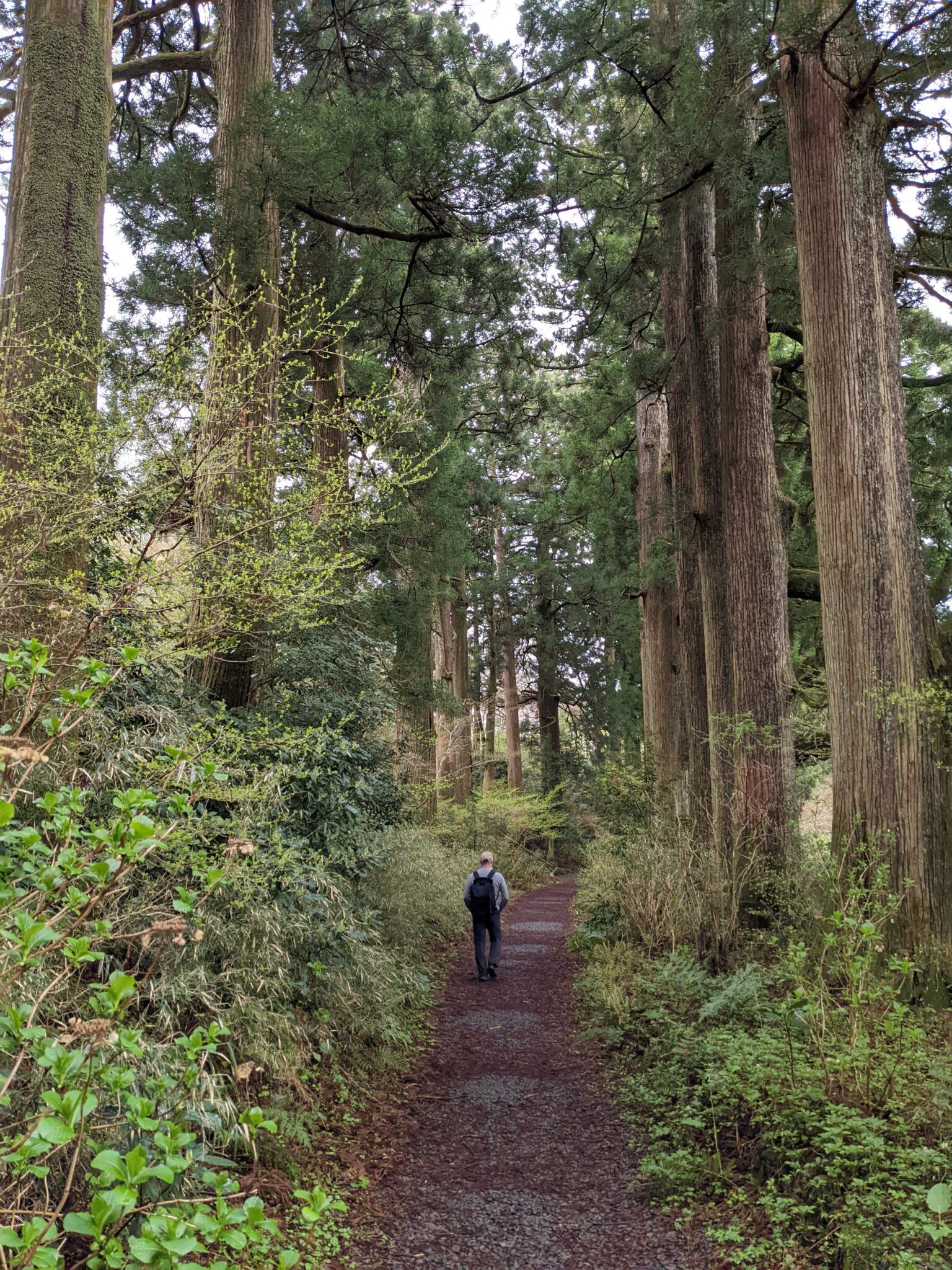
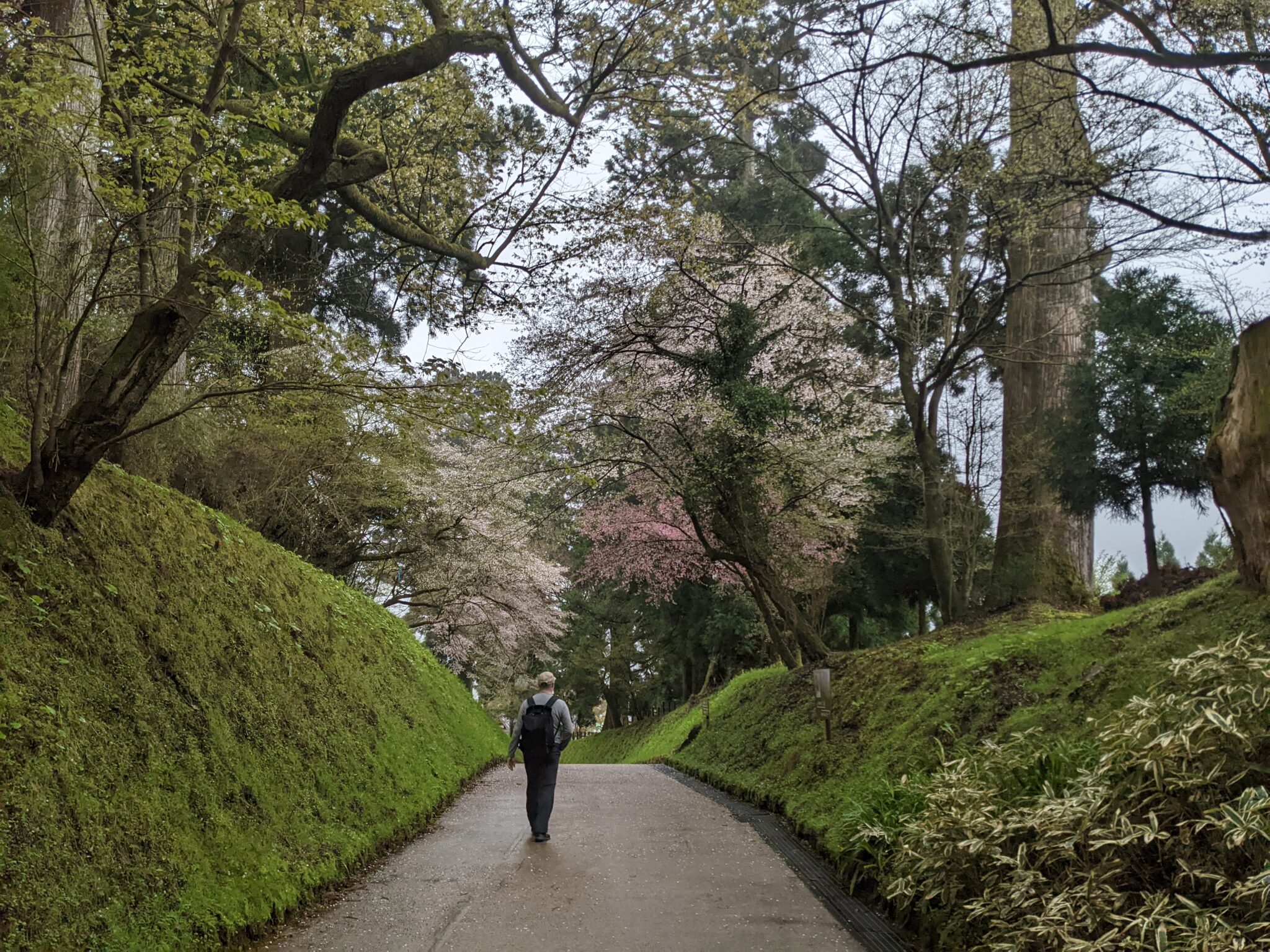
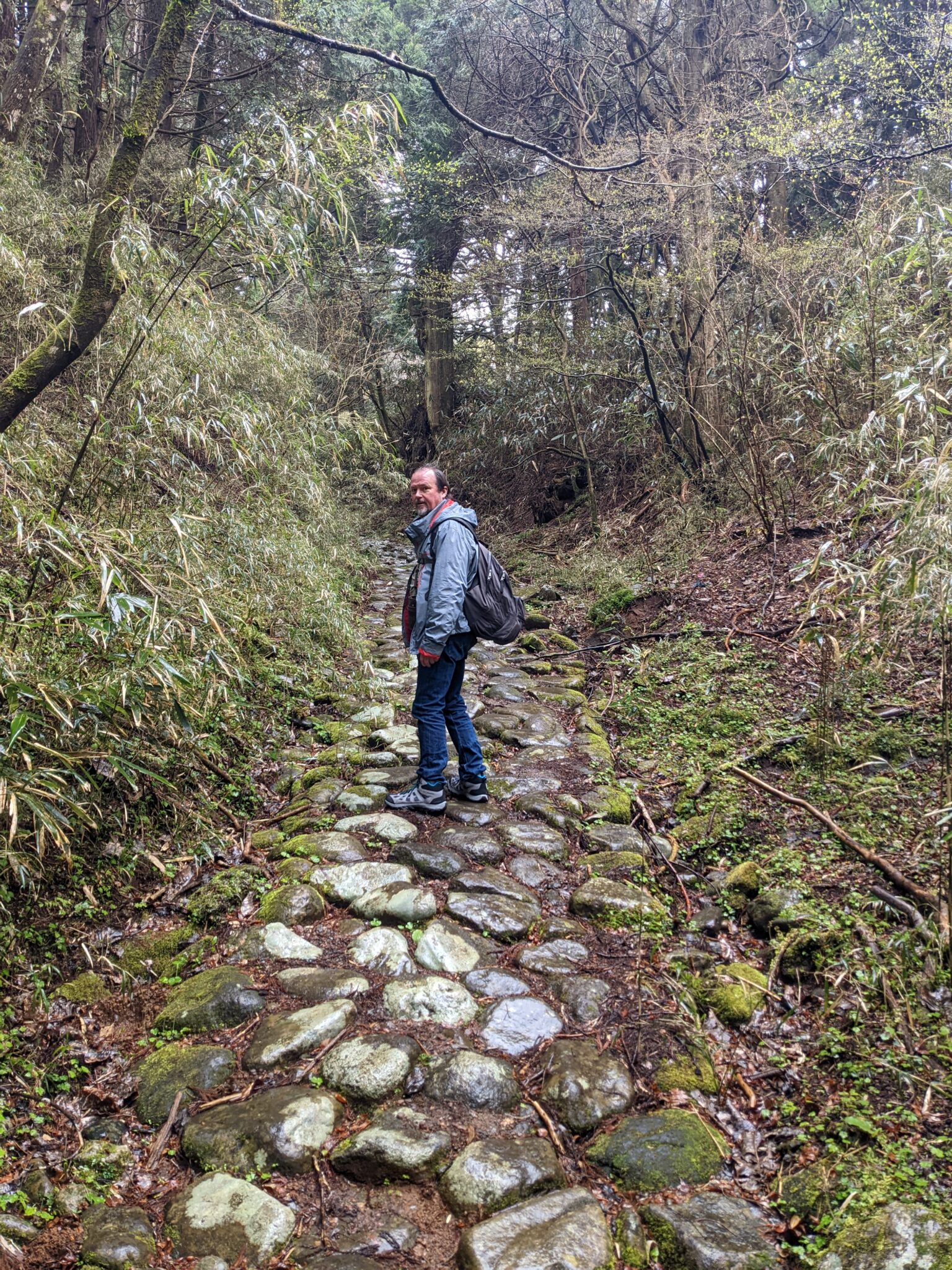
About two thirds of the way down the slope we left the old stone road and crossed the modern one into the parking lot of Mishima Skywalk where we met up with my wife and Gerhard’s lady friend, pretty close to the time I had estimated. We paid our ¥1,100 entry fee and started walking across the 400 meter-long suspension bridge, the longest in Japan. Mt. Fuji would loom large off to the west on a clear day. But it was not to be seen on this day due to a light rain that was falling. Because of the rain—really more of a mist—and the danger of being blown off the bridge if a wind gust hit an open umbrella, small plastic ponchos were being handed out, something that may come in handy in the future.
Despite not being able to see Fuji-san, the scenery was still quite beautiful, especially the mountain sakura trees that were still in bloom. There was a steady stream of people crossing the chasm below on zip lines, something that looked like fun but we had to pass on because of a lack of time.
The walk was pretty easy from Skywalk on into Mishima. I had made reservations for us at a Unagi-izakaya called Sakura-ya (桜屋), a restaurant dating from Ansei 3 (1856), the end of the AEdo period. This was the same place my Tōkaidō walk friends ate the day they did the walk. And it just happens to be located on the old Tōkaidō road. I had asked for reservations at 7:00 as I wasn’t sure what time we would be ready. Since we arrived in plenty of time, around 4:30, we called and moved our reservation up an hour. Because it was raining quite hard by 5:30, we ended up taking a taxi to the restaurant.
We ordered a round of beers then started looking over the menu to see what we wanted to eat. First was a couple of dishes of unagi senbei (fried spine bones), then peanuts tōfu, something new for all four of us. Next came an order of tamago-yaki maki, with unagi inside, some kimo-shigeruni (きも時雨煮, unagi livers simmered in a shōyu based sauce), and an order of four unagi shūmai, again, something new to all of us and also very tasty. About this time the tsukemono (pickles) arrived, a sign the unagi was almost ready.
Sakura-ya buys live unagi every morning from a local unagi farmer, and the freshness was obvious. Gerhard, the big eater, ordered double unagi, which was rice topped with a layer of unagi topped with another layer of rice and finally another two pieces of unagi smothered in sauce. It was a lot, but we all managed to finish it all. And somewhere along the way we ordered some local sake which arrived in a very large pouring bowl.
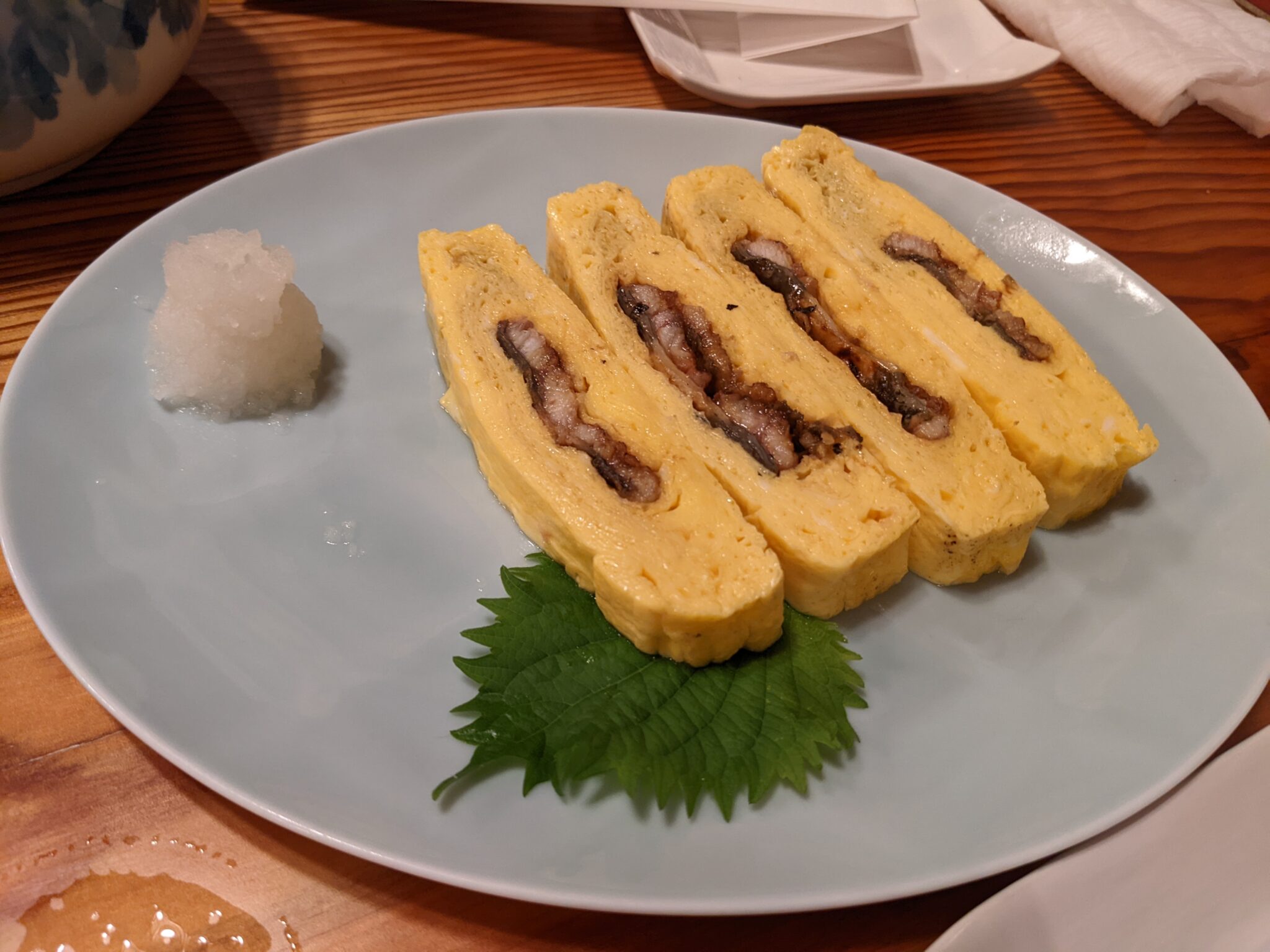
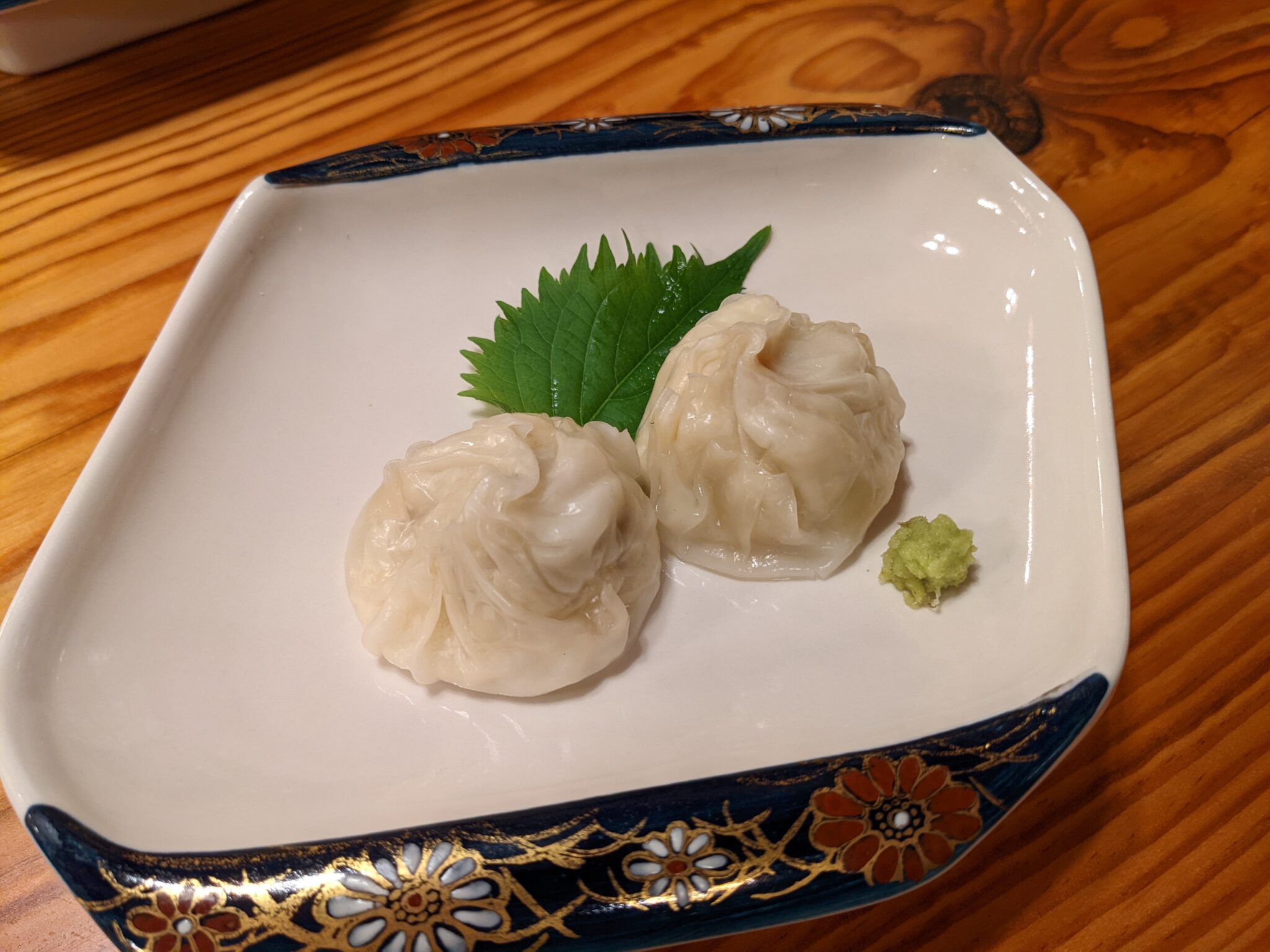
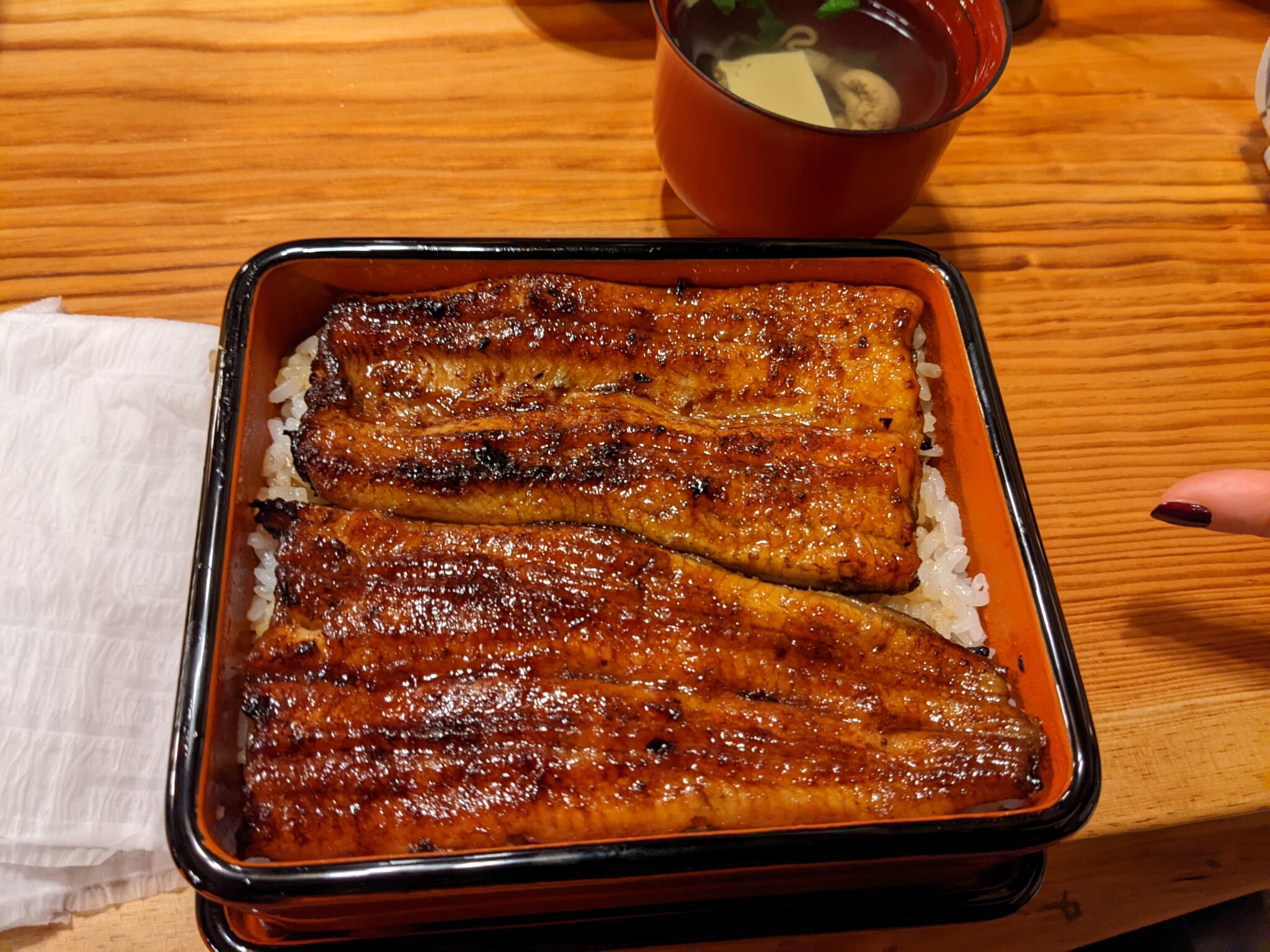
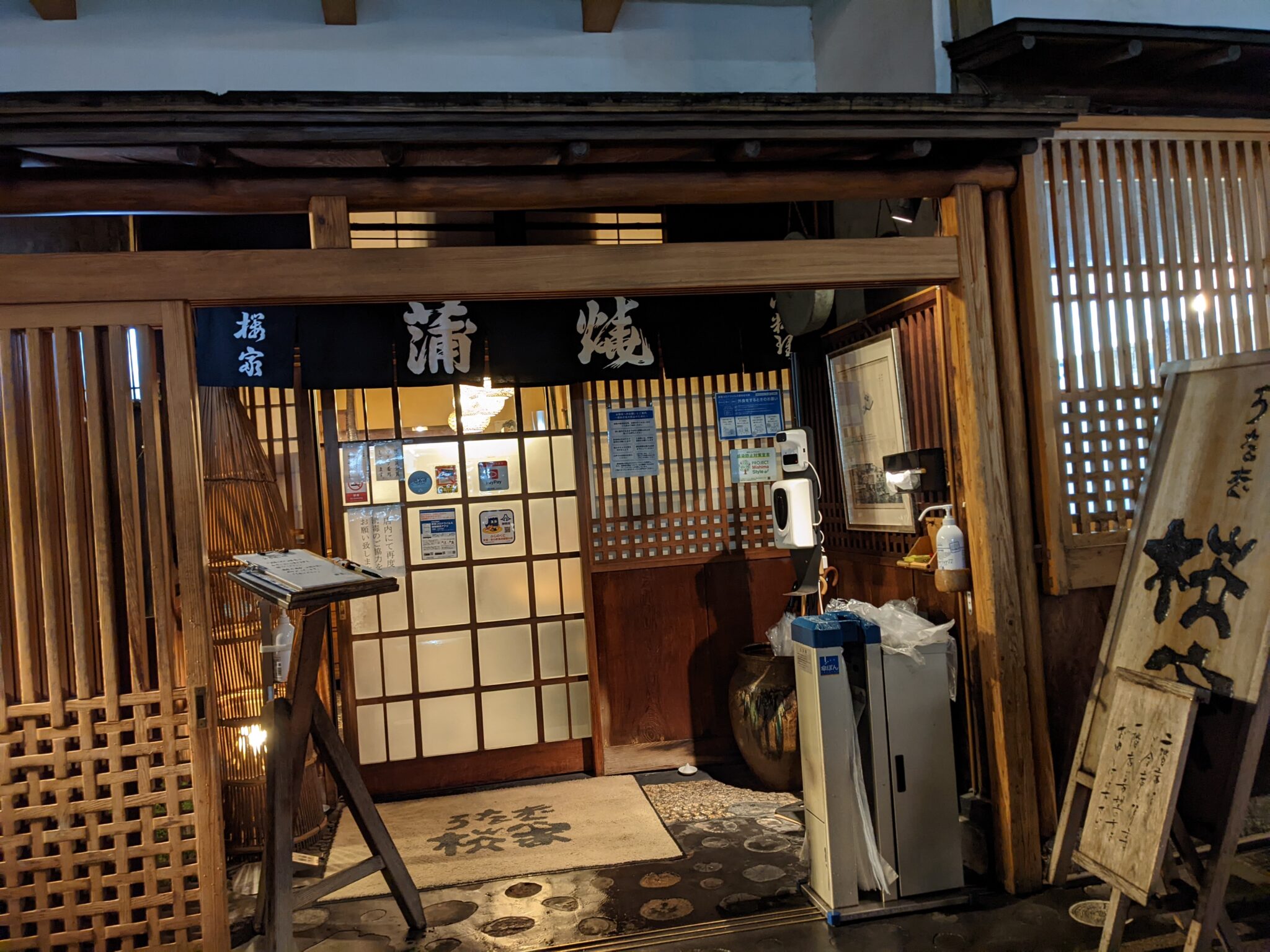
It was still raining as we finished, so Okami-san called a taxi to come pick us up. The driver—a local woman—got there in a hurry, causing her to have to wait a minute or two before we were ready to go. Just like the earlier taxi, this one was also one of the new, Olympic Toyota van-type cabs, so easy for the four of us to get in and out of. How do I know the driver was a local? She took some back-alley type streets and delivered us to the hotel’s drop-off door. And cheaply too.
http://www.sakura-ya.net/
Knowing we were going to be eating a huge meal of tenpura at noon, Tuesday morning started with just a glass of juice and an apple. After sending our one small suitcase home via Yamato/Kuro Nekko and checking out of our hotel, we hopped on a shinkansen for a quick ride down to Shizuoka City, arriving early enough for a leisurely 2 km stroll to Narusei for what may very well be the best tenpura in Japan.
It had been almost exactly one year since my wife and I last made the trip to Narusei. The biggest difference this time was the return of glass screens in front of the oil kettles, something that had been at the former location but until recently not at the new place, now just over one year old. I must admit I welcomed the return of the glass as it is kind of fun, and educational, to be able to watch a pro cook tenpura. Or anything else, for that matter.
After sitting down, we decided to do a wine pairing with our meal; Narusei-san’s wife, the sommelier, has a good sense for what goes well with the various courses. The meal began with some sashimi, aka-gai and another shellfish. After that came slightly warmed/cooked hata (grouper), the flesh cut from a 30 kg fish and cooked in 40 C oil. That was followed by a procession of fish and vegetables, including pieces of a monstrous cudgel of gobō, for lack of a better term for what looked like the type of club a caveman might have carried. The meal finished with kake-age tenpura, served either over rice ten-don style or in rice and tea, which was followed by some fruit and finally a bowl of sencha in the room next door. After paying and making our next booking we headed out for a pleasant walk through the grounds of the shrine next door and on back to the station, stopping along the way outside the grounds of the old Sunpu Castle for some photos with statues of my old Tōkaidō Road travel mates Kita and Yaji.
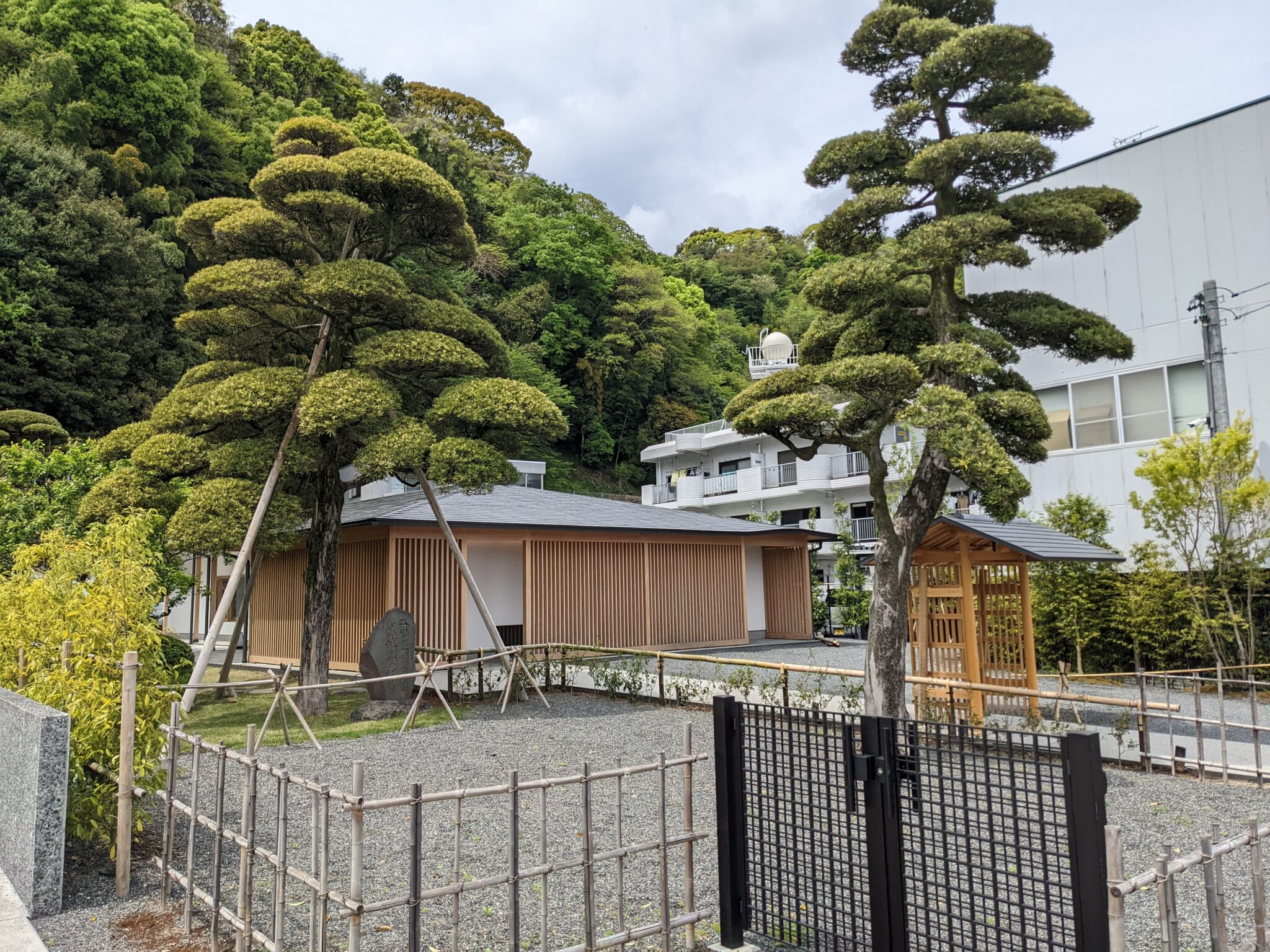
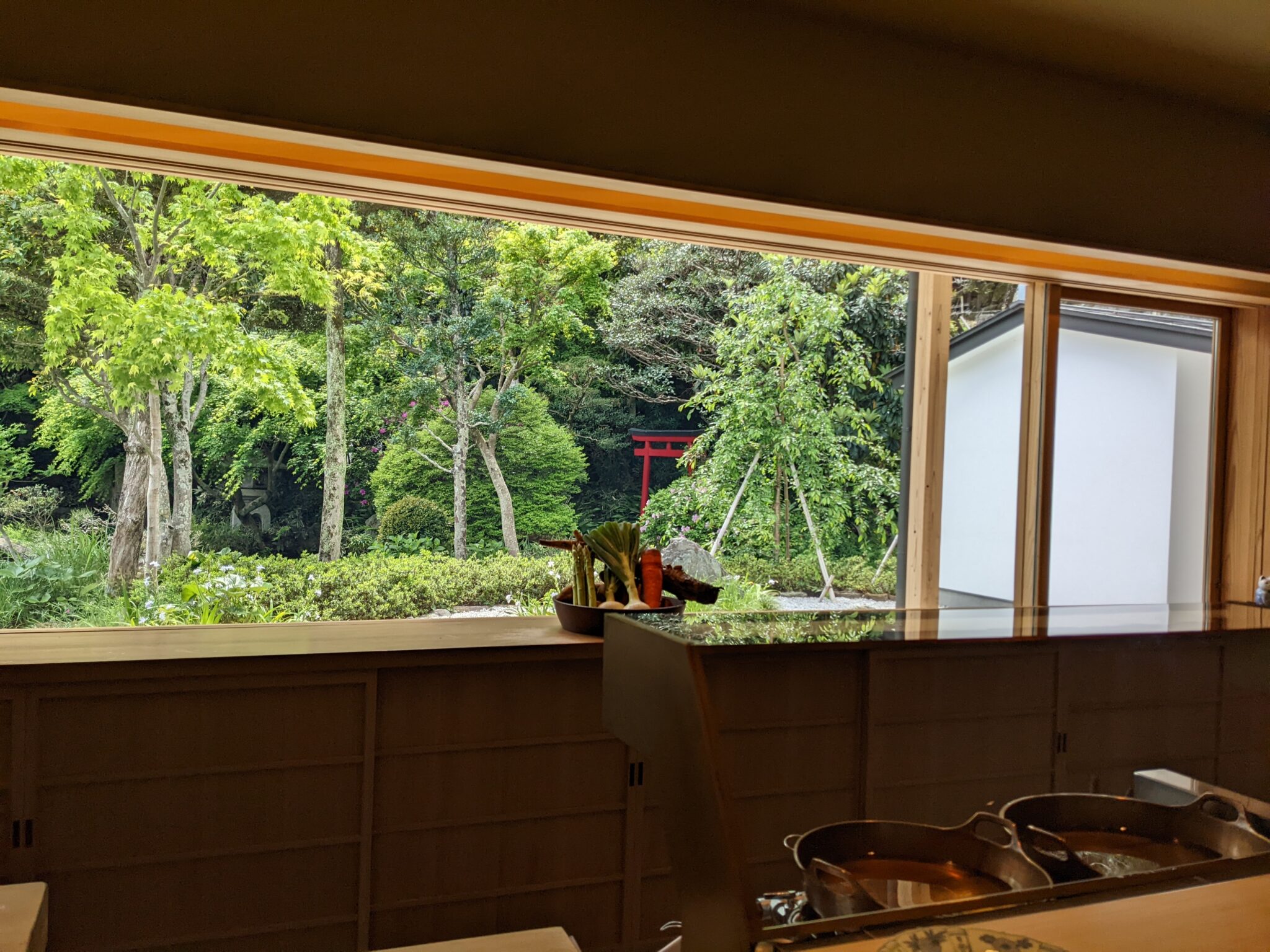
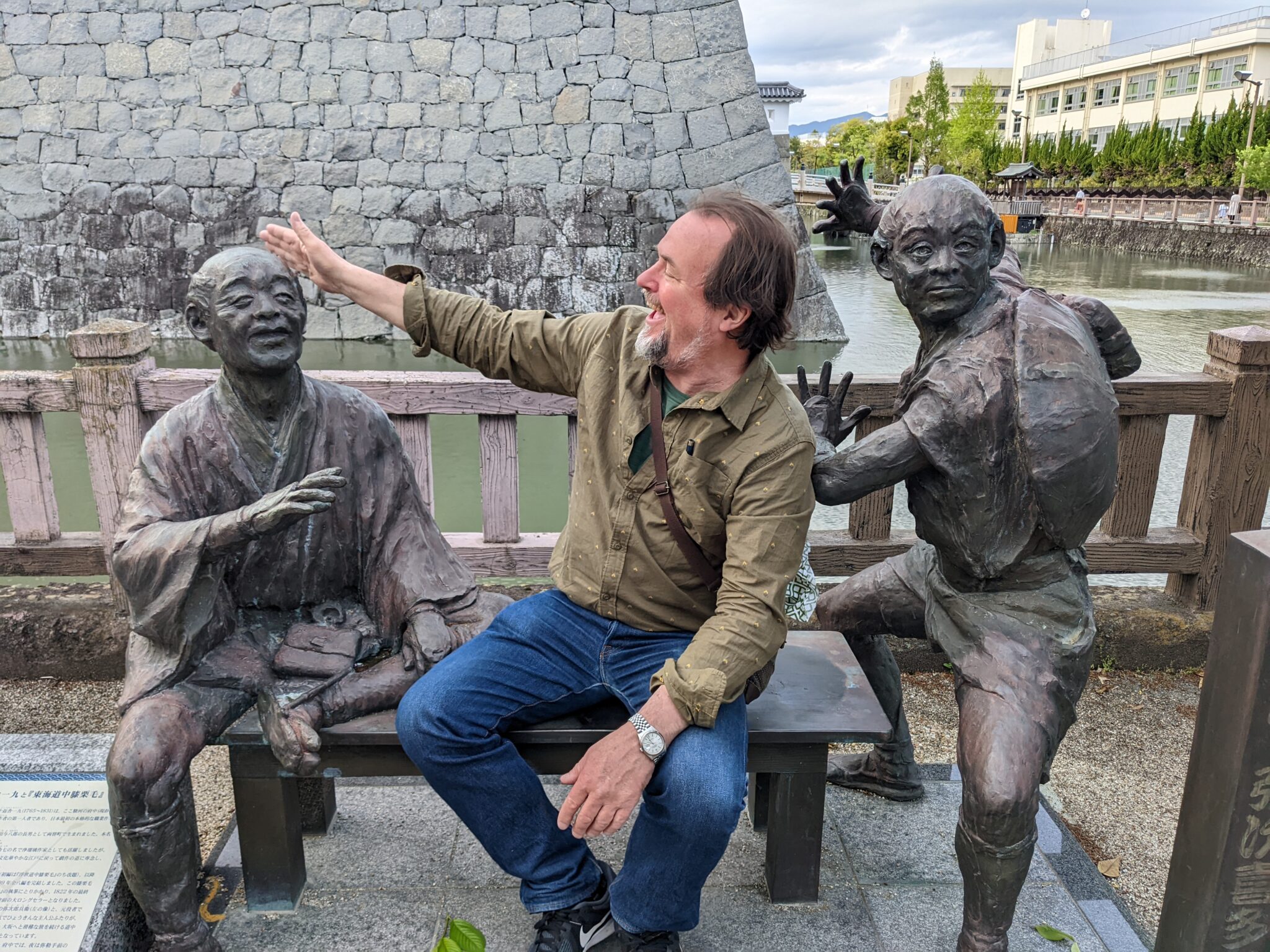
Back in Tokyo that night neither my wife or myself had much of an appetite. A small snack was all we needed.